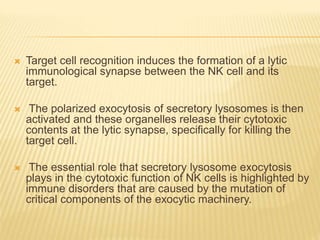killer cells.ppt
- 1. KILLER CELLS Prepared by: Halala Dlzar Dhahir Supervised by: DR. Amanj saeed
- 2. INTRODUCTION: A type of immune cell that can kill tumor cells or cells infected with a virus. There are two major types of killer cells: Natural killer cells. T killer cells (cytotoxic killer cells)
- 3. NATURAL KILLER CELLS: Natural killer (NK) cells are effector lymphocytes of the innate immune system that control several types of tumors and microbial infections by limiting their spread and subsequent tissue damage.
- 4. NK cells were originally described as large granular lymphocytes with natural cytotoxicity against tumor cells. NK cells were later recognized as a separate lymphocyte lineage, with both cytotoxicity and cytokine-producing effector functions.
- 5. NATURAL KILLER CELL TARGET RECOGNITION: Natural killer (NK) cells target and kill aberrant cells, such as virally infected and tumorigenic cells. NK cells can recognize and kill cells that have down- regulated MHC class I molecules from their cell surface. The MHC class I molecules are recognized by NK cell inhibitory receptors and the ligation of these receptors inhibits the activation of NK cells. Conversely the lack of engagement of these receptors can activate NK cytotoxicity
- 6. Target cell recognition induces the formation of a lytic immunological synapse between the NK cell and its target. The polarized exocytosis of secretory lysosomes is then activated and these organelles release their cytotoxic contents at the lytic synapse, specifically for killing the target cell. The essential role that secretory lysosome exocytosis plays in the cytotoxic function of NK cells is highlighted by immune disorders that are caused by the mutation of critical components of the exocytic machinery.
- 7. T KILLER CELLS: Natural killer T (NKT) cells are lymphocytes that express both a T-cell receptor (TCR), characteristic of adaptive immunity, and surface receptors for NK cells, which are part of the innate immune response. These cells influence diverse immune responses, including the surveillance for tumors, the maintenance of self-tolerance and the regulation of autoimmune diseases.
- 8. STRUCTURE OF T KILLER CELLS: T-cells have many identical T-cell receptors that cover their surfaces and can only bind to one shape of antigen. When a T-cell receptor fits with its viral antigen on an infected cell, the Killer T-cell releases cytotoxins to kill that cell.
- 9. FUNCTION OF CYTOTOXIC KILLER CELLS: T cells are generated in the Thymus and are programmed to be specific for one particular foreign particle (antigen). Once they leave the thymus, they circulate throughout the body until they recognize their antigen on the surface of antigen presenting cells (APCs). The T cell receptor (TCR) on both CD4+ helper T cells and CD8+ cytotoxic t cell. cytotoxic T cells binds to the antigen as it is held in a structure called the MHC complex, on the surface of the APC.
- 10. In order for the TCR to bind to the class I MHC molecule, the former must be accompanied by a glycoprotein called CD8, which binds to the constant portion of the class I MHC molecule. Therefore, these T cells are called CD8+ T cells. This triggers initial activation of the T cells. The CD4 and CD8 molecules then bind to the MHC molecule too, stabilizing the whole structure. This initial binding between a T cell specific for one antigen and the antigen-MHC it matches sets the whole response in motion. This normally takes place in the secondary lymphoid organs.
- 12. PULLING THE TRIGGER: SECRETORY LYSOSOME EXOCYTOSIS: Secretory lysosomes are dual function organelles that combine the degradative function of conventional lysosomes with the capacity to undergo regulated exocytosis. The major cytotoxic proteins contained within secretory lysosomes in NK cells and CTLs are the granzymes and perforin. Target cell recognition induces secretory lysosome exocytosis and the release of the cytotoxic contents of this organelle.
- 13. Perforin then facilitates the entry of the granzymes into the target cell cytoplasm, where they cleave a variety of targets, such as caspases, resulting in cell death.
- 14. To ensure that NK cells do not kill indiscriminately, the exocytosis of secretory lysosomes is a tightly regulated and highly ordered process. For the purposes of this review it can be divided into four stages: 1. an activating, lytic immunological synapse forms at the point of contact with the target cell, and there is a rearrangement of the actin cytoskeleton. 2. the microtubule-organizing centre (MTOC) of the NK cell and the secretory lysosomes are polarized towards the lytic synapse. 3. secretory lysosomes dock with the plasma membrane at the lytic synapse. 4. fusing with the plasma membrane and releasing their cytotoxic contents.
- 15. REGULATION OF KILLER CELLS BY INTERFERON: IFN-γ production is important when considering potential mechanisms of metabolic regulation of this critical cytokine in NK cells. Regulation of IFN-γ production in NK cells shares many aspects with T cells, including the signaling pathways and transcription factors (TFs) required for efficient transcription.
- 16. However, a crucial difference between NK and T cells is that mature NK cells have an epigenetically accessible Ifng locus and constitutively express IFN-γ transcript, whereas T cells do not. Acute transcription of Ifng requires nuclear factor kappa light-chain enhancer of activated B cells (NF- κB) activation, which is induced by the activating receptors NKR or T-cell receptor (TCR) and/or the cytokines interleukin-1 (IL-1) or IL-18
- 17. IFN-γ protein expression is regulated at multiple levels, including epigenetically, transcriptionally, and post-transcriptionally.
- 18. killer cells can be activated by three complementary and often overlapping routes: 1. engagement of germline-encoded activating NKRs that recognize stress- and virally induced ligands on target cells in the absence of a strong inhibitory NKR signal. 2. recognition of antibody-coated target cells through the activating Fc receptor CD16 (antibody-dependent cellular cytotoxicity). 3. activation by innate and adaptive immune cytokines including IL-1, IL-2, IL-12, IL-15, and IL-18.


















